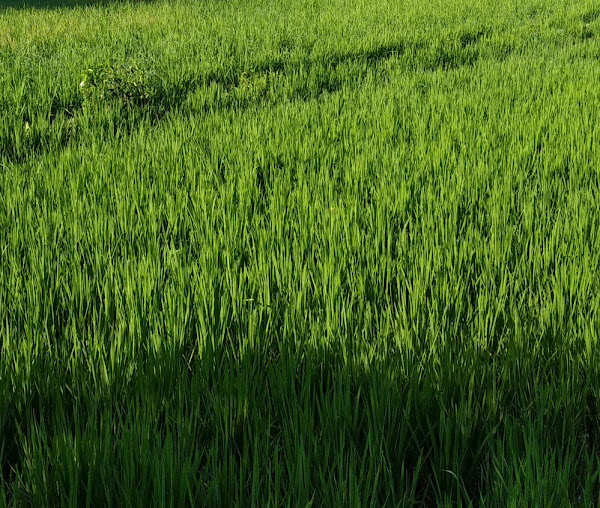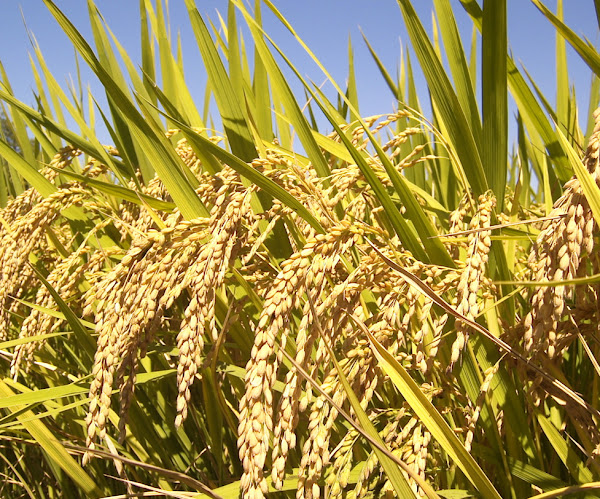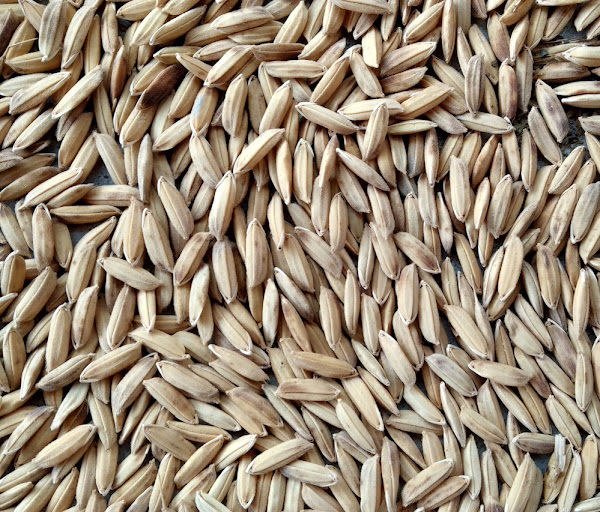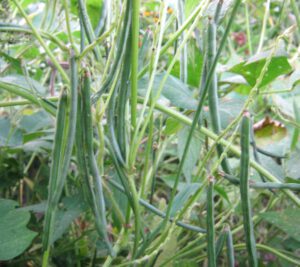If you are wondering ‘how is rice grown‘, then you are in the right place. Here we are describing more about rice farming business. Rice farming is very common and popular throughout the world. And rice is the number one and most widely consumed staple food in the world.
Rice is consumed as staple food by a large part of the world’s human population (especially in Asia). Is actually the seed of the grass species Oryza sativa (or Oryza glaberrima for African rice). Rice (a monocot) is normally grown as an annual plant.
But in the tropical areas, the rice plants can survive as a perennial and can produce a ratoon crop for up to 30 years. Depending on the variety and soil fertility, the rice plant can grow from 3.3 feet to 5.9 feet tall or even more.
Leaves of the rice plants are 20-39 inches long and less than 1 inch broad (typically 0.79-0.98 inch). The flowers are very small and are wind pollinated.
The flowers are produced in a branched arching to pendulous inflorescence 12-20 inches long. And the edible seed is a grain (caryopsis) which is 0.20-0.47 inch long, and 0.079-0.118 inch thick.
Rice farming is well-suited to countries and regions with low labor costs and high rainfall. Because, rice farming requires ample water and it is labor-intensive. Although, rice can be grown almost anywhere (even on mountain area or steep hill with the use of water-controlling terrace system. Rice actually grows well in Asia and certain parts of Africa.
Rice is the most popular staple food and it is used in many different ways. A major amount or portion of sugarcane and maize crops are used for purposes other than human consumption.
But rice is the most important grain with regard to human nutrition and caloric intake. Rice is providing more than one-fifth of the calories consumed worldwide by humans.
What is Rice Farming?
Before discussing more about this business, let us first explain what rice farming actually is. Rice farming is an agricultural process of cultivating rice. This process involves several steps from land preparation, planting to caring and harvesting.
Rice Nutrition
Rice is the most important grain with regard to human nutrition and caloric intake (providing more than one-fifth of the calories consumed by humans worldwide).
It is the staple food of over half the world’s population. According to Wikipedia, cooked, unenriched, white, long-grained rice is composed of 3% protein, 28% carbohydrates, 68% water and negligible amount of fat’.
And in 100 gram cooked rice serving, it provides 130 calories and contains no micronutrients in significant amounts (with all less than 10% of the Daily Value).
Cooked, white, short-grained rice also provides 130 calories and contains moderate amounts of B vitamins, iron, and manganese (10–17% DV) per 100 gram amount.
Health Benefits of Rice
Rice is the staple food of over half of the world’s population. Most of the people eat rice without knowing or caring about it’s health benefits. However, some notable health benefits of rice are;
- It is a good source of energy and it’s cholesterol free.
- Rice is a moderate source of some vitamins and minerals.
- Rice bran oil is considered healthy, and it supports cardiovascular health.
- Consuming rice is good for preventing skin problems and also helps in preventing chronic constipation.
- Rice is said to help in cancer prevention, and also helps in blood pressure management.
How is Rice Grown?
Rice farming is very easy and simple, and you can start growing rice if you are a beginner. Rice can be grown in different types of soil and different environment, depending on the availability of water. Here we are describing everything about rice farming from planting, caring to harvesting.

Step 1. Select A Good Location
First of all, you have to select a very good location for rice farming. Rice plants are versatile, and they can be grown on a wide variety of soil types with low permeability and pH varying from 5.0 to 9.5. The rice plants require full sun, so the selected land should have access to full sun.
Depending on the availability of water, rice can be grown in many different environments. The plants can be grown in both irrigated and rainfed method, and they can also survive flooding. However, favorable rice growing environments are;
- Coastal wetland
- Deep water or floating rice
- Lowland, irrigated (rice is grown in both the wet season and the dry season)
- Lowland, rainfed (which is drought prone, favors medium depth , watrlogged, submergence and flood prone)
- Upland rice
Step 2. Preparing The Soil
Rice farming is possible in a wide range of soil types. Sandy loam to loamy sand to silty loam to clay loams, silty to clayey loam soils with low permeability, free of sodicity are considered best for rice farming.
Whatever the soil type is, you have to prepare it perfectly for growing rice. You have to ensure that the soil is in it’s best physical condition for crop growth and the soil surface is level.
Land preparation for rice farming involves plowing and harrowing to ’till’ or dig-up, mix and level the soil. Tillage helps with weed control, and also allows the seeds to be planted at the right depth. And then you have to level the surface for reducing the amount of water wasted by uneven pockets of too-deep water or exposed soil.
Semi-dry, dry and wet systems are generally followed in rice farming. The dry and semi-dry systems of rice farming depends on rains, and generally do not have supplementary irrigation facilities.
On the other hand in wet rice farming system, the rice crop is grown with assured and abundant water supply either by rain or by irrigation. We are describing about all these systems below.
Dry and Semi-Dry System
For rice farming in these system, you have to prepare the field by giving several ploughings and harrowing. While ploughing and harrowing, add lots of organic contents into it. You should add organic contents into the soil at least 2-4 weeks before sowing or planting.
Wet System
In wet system, plough the field thoroughly and puddle with 3-5 cm of standing water in the field. The ideal depth of puddling is found to be around 10 cm in clay soils, clay-loamy soils. Level the land after puddling, and doing this is important to facilitate a uniform distribution of water and fertilizers.
For commercial rice farming business, you also have to apply some chemical fertilizer for generating maximum yield. Although exact amount of fertilizers can vary from place to place. On average, you will need to apply around 50 kg Nitrogen, 12 kg Phosphorus and 12 kg Potash. Conduct a soil test before applying chemical fertilizers into it. And if possible consult with an agriculture specialist in your area for having good recommendation.
Step 3. Consider The Climate Requirements For Rice Farming
Rice plants can be grown in a wide variety of climatic conditions. They can also be grown under widely varying conditions of altitude, and they can be cultivated as high as 3000 meter above sea level.
Actually relatively hot and humid climatic conditions are considered good for rice farming.
Rice is best grown in areas/regions where abundant water supply, prolonged sunshine and high humid condition is available. Temperature between 16 °C and 30 °C is considered best for rice farming.
Step 4. Best Time For Rice Farming
Rice can be grown at any time of the year. The seeds will germinate and the plants will grow well as long as the temperature is between 16 °C and 30 °C (although the plants can survive as high as 40 °C).
Step 5. Choose A Variety
There are many varieties (actually too many varieties) or cultivars of rice available throughout the world. Rice varieties and types are divided into different categories depending on culinary preferences, characteristics and also vary regionally.
Depending on region, there are hundreds or thousands or even more rice varieties available and new varieties are being developed continuously.
In case of regional rice varieties, there are countless rice varieties available. Each of these varieties are found in specific region. For example ‘Kalo Beruin, Khato Dosh, Lapha, Balam, Bashmoti, Bina, Chinigura, Digha, Gadai Lashkari, Katari Bhog, Miniket, Mou Beruin, Moulata, Pajam and Thakur Bhog are some Bangladeshi rice variety. Bhut Muri, Hansraj, Dubrej, Hay Shrirama, Kamini, Patna and Laxmi Bhog are some Indian rice varieties.

In case of culinary preferences, the varieties of rice are generally classified as long, medium and short grained. The long grain rice tend to remain intact after cooking. The medium grain rice becomes more sticky and is generally used for sweet dishes.
And the short-grain rice is often used for rice pudding. And within these 3 varieties there are several cultivars available around the world.
Many different rice varieties available depending on the characteristics or color. Brown, white, red, black and purple colored rice varieties are available.
There are also many different improved or hybrid rice varieties available. These improved varieties are highly productive and yield more than the traditional varieties.
However, you have to choose a rice variety deepening on it’s availability in your area and you also have to consider your production purpose while selecting a variety.
But you should always choose the local varieties which are easily available in your area. Please contact your local govt. or private seed manufacturer for getting high yielding, disease resistant varieties.
Step 6. Purchase Seeds
After selecting your desired variety, purchase seed from any of your local suppliers. Consider purchasing good quality, high yielding and disease free seeds from any of your local govt. or private seed manufacturer.
Step 7. Determine How Much Seeds Per Acre
Exact amount of seeds depend on the rice variety and also on the method you are going to follow for rice farming. Generally, 10-12 kg seeds will be enough for direct sowing, and 25-30 kg will be enough for transplanting method.
Step 8. Planting
The rice plant is grown in two ways. They are grown either by direct seeding or by transplanting. Whichever system you use, you should treat the seeds by fungicide/insecticide before sowing.
Direct Sowing
In direct seeding system, you have to broadcast dry seed or pre-germinated seeds by hand or by using a machine. The dry seeds are manually broadcasted onto the soil surface in rainfed and deepwater ecosystems, and then incorporated either by ploughing or by harrowing while the soil is still dry.
But the seeds are generally pre-germinated prior to broadcasting in the irrigated areas. This is very easy method and requires less labor.
Transplanting
Transplanting is the most popular rice planting method across Asia. In this system, the seedlings are grown in a prepared seedbed and then transplanted to the main wet field. This system requires less seed and it is an effective method for controlling weeds.
Transplanting method require more labor, although today there are some machines available for planting the transplants which will reduce the use of labor.
Step 9. Caring
Taking additional care is a must for rice farming. Rice is not a plant and then harvest crop, and the plants require lots of care. Here we are describing more about the caring process for growing rice.

Fertilizing
Applying additional fertilizers is needed for maximum yield. Don’t apply all these chemical fertilizers into the soil at once while preparing the soil. Apply all the organic fertilizers and half of the chemical fertilizers during preparing the soil. And then apply remaining half chemical fertilizers twice with 30 days interval.
Watering
Cultivated rice is extremely sensitive to water shortages. Maintaining a flooded condition in the field is good for ensuring sufficient water during the growth period (do this especially for lowland rice farming).
In rainfed rice farming conditions, you don’t have to think much about it and nature will do the rest. But in case of dry or semi-dry conditions, you have to water the field regularly. Remember, you must have to keep the field flooded for up to 2 weeks after transplanting.
Controlling Weeds
Controlling weeds is very important for rice farming. Weeds consume nutrients from the soil, so you have to remove them from the field. Manual weeding or chemical weeding both are used for commercial rice farming business. Consult with your local agriculture specialist for having good recommendation.
Step 10. Control Pests and Diseases
Rice plants are susceptible to some pests and diseases, just like many other commercial crops. The rice plant has a wide array of ‘enemies’ in the field including rodents, harmful insects, viruses and diseases.
Understanding the interactions among pests, natural enemies, host plants, other organisms, and the environment allows farmers to determine what if any pest management may be necessary.
It’s always good to keep good contact with an agriculture specialist in your area for controlling all these pests, diseases or other problems.
Step 11. Harvesting and Yield
Depending on the variety, the rice plants reach maturity at around 105 to 150 days after crop establishment. You can start harvesting the crop when the moisture content into the grain reduce to 20%-25%. Rice harvesting activities include cutting, stacking, handling, threshing, cleaning and hauling.
You can do all the harvesting activities either by hand or by using a machine. And remember, good harvesting methods help to maximize grain yield and minimize grain damage and deterioration.

Manual Harvesting
Manual harvesting is very common across Asia , and it involves cutting the rice crop with simple hand tools like sickles and knives. Manual harvesting is good and actually very effective when a crop has lodged or fallen over. But manual harvesting is labor intensive and sometimes costly.
Mechanical Harvesting
Mechanical harvesting is easy and is less labor intensive. Mechanical harvesting is done using reapers or combine harvesters. Mechanical harvesting is not common or popular in most areas mainly due to the availability and cost of the machinery.
Yield
Total yield can vary depending on various factors such as chosen variety, soil type, cultivation method, farm management practices etc. On average, with modern improved varieties, you can expect about 1500 to 2000 kg per acre.
Hope you have enjoyed this guide. Rice is the most economically important crop around the world. And commercial rice farming business is very profitable if you can do everything perfectly. Good luck!






YOU HAVE CREATED JOB TO MANKIND MAY GOD BLESS
[email protected]
ALIYU BAPETEL
Thanks for your honest opinion. May God bless you! Good luck!
You have raised my long lost hope of starting a rice farm THANK YOU
Is it possible to start rice farming by using cow manure only. Today chemical fertilizers are very costly. How about the production if I use only cow manure and organic pesticides produced in desi system? Please help me by sharing your thoughts about this. By the way, I am from Kichha, Uttarakhand, India. I need your opinion very urgent.
Yes, sure! Quality of such organic products is much much better. Production may be less for first 1-2 years, but don’t worry it will increase gradually once the land is fertile enough and rich with organic substances. Uses of chemical fertilizers damage the soil. On the other hand, uses of organic fertilizers make the soil live, breath well and produce more. Uses of organic pesticides is also beneficial. Nowadays, people don’t want to work hard and go for easy solution. Uses of organic fertilizers and pesticides involves lots of work. That’s why most of the people go for chemical uses, because it is easy just buy it and spread it. But longer application of chemical fertilizers and pesticides is dangerous for our health and environment. Conscious people like you can surely make a difference. May God bless you!